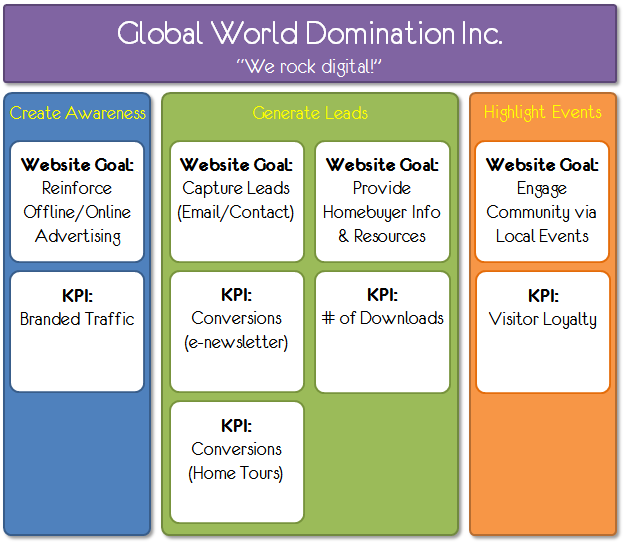The reason why most of the digital marketing campaigns fail to create an impact is not the lack of facilities such as banner ads or TV spots, neither it is because of the people involved. (Well, most of the time.) The original cause is the lack of an objective, a definite ‘goal’. This is what differentiates a winner from a mediocre.

Below is a simple and organized, 5 step process which will help you understand more about the Digital Marketing & Management Model
- Step one – To realize the business objectives beforehand and set the long-term guidelines for the work we are doing. Sr. Executives play a key role in this step.
- Step two – To create unique goals for each business objective. Executives lead the discussion, you’ll play a contributing role.
- Step three– To write down the real potential indicator. You will play a key role here but you also need valuable inputs from a ‘data person’.
- Step four– To set identifying targets for each KPI. Organization leaders play a key role here, with contribution from Marketing and Finance.
- Step five – The final and most important step is to analyze the behavior/ outcomes and productivity of people. This will help you understand why you succeeded or failed.
Before we understand each step, in detail, let’s brief ourselves with some very crucial factors.
A complete Digital Marketing & Measurement Model will focus on three key areas of your marketing, and in each answer the cluster of questions provided:
1. Acquisition –
- What steps are you taking to get traffic for your website, YouTube Video or whatever content you are creating?
- Are you looking at all the three components of prosperous acquisition: Earned, Owned, Paid media?
- Where are you putting maximum efforts?
2. Behavior –
- What is the real-time experience you are expecting the customer to have?
- What are they going to watch or what actions are they supposed to take on your website?
- Do you want to build loyal customers who should return again and again or will you focus more on attracting new customers?
3. Outcomes –
- What are the conversions that you are expecting?
- Will they be in the form of downloads, phone calls, online leads, subscription or sign ups?
- Will you be focusing more like an e-commerce website where they try to sell your products or will you be a serving website?
- In simple words: Why are you undertaking the digitalized strategy?

Before proceeding any further, I hope that your ‘Digital Marketing and Measurement Model’ will cover all these questions and you are absolutely clear about what you want and what you don’t. If your model doesn’t answer these questions please revise them because a solid base will ensure your victory in the long run.
Let’s look at a real example of the 5-step process to solidify this concept
Step 1: Realizing the business objectives
Why does your website/campaign exist?
This is a difficult question to answer because it requires more thinking than you might anticipate. If you do it right at the end of step one, you’ll have something that looks like this:

The objective of any discussion should be to get clear answers. Once you have brainstormed the ideas with your seniors and have a clear understanding. This is how the objectives will look: Create awareness, generate leads and highlight events.
Your objectives should always be DUMB:
- D – Doable.
- U – Understandable.
- M – Manageable.
- B – Beneficial.
Always go for the real doable objectives. Always be realistic with your goals.
So, are your objectives dumb? (Sounds funny, ha?)
Step 2: To create unique goals for each business objective
With the management on the top, along with the marketers and analysts, think about the small objectives, goals that will together complete your DUMB objectives.
After going through the acquisition, behavior questions and other important factors, here’s an example of how your model might look:

There should be clarity between goals and how to proceed towards the goals.
These goals not only provide precision, but they also contain specific step-by-step proceeding orders for what the Marketers and Analysts need to get done.
If the goals identified don’t cover all the jobs that your site/campaign is doing then you might need to re-evaluate your work.
Step 3: To write down the ‘Key Performance Indicator’ (KPI)
Finally, this is the part where ideas play the lead role.
So, what is a KPI?
‘A metric that helps you understand how you are doing against your objectives.’ This is probably the simplest way to describe KPI.
For each goal, it’s very important that you find the most hyper-relevant KPI.
Here’s specific guidance to help you look for smart KPIs:

Invest time in finding the right KPIs. The process might be long and laborious, but if you’re planning to achieve something in the long run, this is your boarding pass to that path.
This concludes the first article on the Digital Marketing series. The next article will cover the final two steps with some bonus contents.
Reference –
- Digital Marketing and Measurement
- Wikipedia
- Google Images












